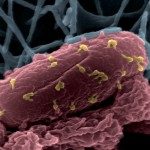Lien vers Pubmed [PMID] – 14507365
Mol. Microbiol. 2003 Oct;50(1):77-88
Haem is involved in essential processes. It is toxic and thus is not found free in living organisms but almost entirely sequestered by haem carrier proteins. We investigated the mechanisms of haem transfer between the proteins of a bacterial haem acquisition system involving haemophores. Haemophores are secreted by several Gram-negative bacteria and are able to extract haem (assimilated as an iron source) from haemoproteins and deliver it to specific outer membrane receptors. The Serratia marcescens haemophore (HasA) is folded into a globular form and tyrosine and histidine are involved in haem ligation. Interaction with the receptor is of high affinity (5 nM) and does not involve haem. Identification and study of mutants with altered binding properties led to the description of two regions of the haemophore that bind to the receptor. They consist of residues involved in two beta strands located on the same side of HasA. Each region is sufficient for high affinity binding. The synthetic peptide corresponding to one beta strand competes with the corresponding haemophore region for binding to the receptor, suggesting that the two binding regions are independent binding sites. We propose a model for haem release and transfer to the receptor.




